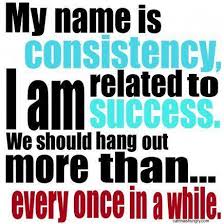The 4 Principles of Success
You need to use just four “Principles of Success” to achieve your vision of it. Here’s a run-down on these principles, and how to use them…
Subscribers to this website know that my posts can be unmercifully long and sciency, but not this one, and for good reasons: Rather than overwhelm you with the hundreds of things one might do to “be” successful, I want to focus on four simple concepts that are easy to apply, and do the job.
Together, the 4 Principles of Success forms the river that will carry you to the destinations you desire, to the stuff that defines success for you.
The first step is to get wet.
If you do not enter the river and get wet, you’re just flirting with success. You’ll remain uncommitted to having the success you imagine, because of just that — it remains imagined.
If you are not applying these four principles of success to whatever it is you want to achieve, you’re still in the imagination stage. Imagination — visualization, if you will — is important, perhaps a vital first step. But at some point you have to get real.
Whether your success is illusive because it still resides only in your imagination, or what you are doing is not working, then it’s time to recalibrate and make some changes.
It’s a simple analysis: If you are today not any closer than you were yesterday to achieving what you want, then something needs changing.
Remember that old saw:
The definition of insanity is doing the same thing and expecting a different result.
And so now I’ve made an assumption — that you need to change something your doing (or not doing) in order to get the success you want. What you change is up to you to figure out, but the “4 Principles” remain in force.
They are:
- Consistency,
- Progression,
- The Plan, and
- Partnership.
It’s OK to begin your river journey by just dipping a toe into the water, but do it every day (“Consistency”), and for a predetermined time period.
Then, it’s OK to just get your feet wet for awhile once your toe-time is over, but just during the time frame you set, after which the legs get wet. (“Progression”).
It’s OK to take the time you need to consistently do the things needed with progressive difficulty as planned on paper. (“The Plan”)
And, about the smartest thing, it’s OK to get help in the form of inspiration, support, direction or firm hands that push you in the river… and jump in after you. (“Partnership”)
That said, let’s dive into the “4 Principles of Success”.
#1 Consistency
There’s a rule of thumb that becoming an expert requires 10,000 hours of practice. Of course, this assertion is more oriented to make a point than to set an exact number of hours. The point is that you have to apply yourself to whatever it is you wish to accomplish consistently.
Getting stronger is a good example.
If you can do five push-ups now, but want to be able to do 16 in three months, you must consistently practice doing push-ups, and perhaps other complimentary exercises. It might be counterproductive to consistently do five push-ups every hour, but you must determine how often your consistent effort will produce the best outcome, and consistently apply yourself to that.
More so than the other Principles, consistency requires habituation. You simply need to carve out the time and place in your daily life to apply yourself to the deed. Since you may already be very busy and have ingrained habits and responsibilities that want to crowd out anything new, you might have to start small.
In order to develop the consistency required to achieve the success you want, the first habit to build might need to be tiny. So tiny that it’s almost laughable. So tiny that it would be silly not to do it. If that’s intriguing, go read How To Make Tiny Habits Big.
#2 Progression
Although consistency is necessary to achieve success, it is not sufficient!
Going back to the push-up example, you could consistently do five push-ups every day for three months minus one day, and although you would be stronger, you might not be able to crank out 11 more on that last day of the third month when you’ve planned for your goal to be achieved.
The consistency of doing five push-ups every day is admirable, but without progression it’s not sufficient to prepare you to do basically double that amount of repetitions on the last day of the third month, which was the goal, and the measurement of your success.
Compare that result to progressively adding one more repetition each week. In this case, by the 11th week in the third month, you’d be doing 15 push-ups, and well prepared to crank out one extra rep on the deadline.
Three of the “12 Ageproof BioHacks” I’m currently developing are detoxification, meditation and mobility exercises. They can serve as additional examples of progression.
Perhaps with the detox biohack, you elect to simply begin with lemon water, but if you are consistent with that and wish to progress, you may plan on doing a complex, multiple-week detox cleanse.
With the meditation biohack, you may at first just calm your mind and listen to some binaural beats, but it could pull you in, and you just might light on fire… and before you know it, you’ll be meditating for an hour each day.
Or those morning mobility biohacks. In the morning! Really? Well, at first you might shuffle to the living room and just rock back and forth, longing for the bed. OK, be consistent and do that every morning, if it’s part of The Plan. At some point in that plan, however, there needs to be progression, and at that point you do more.
Yes, if you give yourself enough time and the goal is modest, consistency may be all you need. You could, for instance, fill up your bathtub with water a cup at a time if you didn’t need to bathe anytime soon. But a pool! That requires the progression of a bucket and then a hose.
Do not forget that you will adjust to whatever you do consistently, thus making it easy. Once it’s easy, you’re no longer progressing. It’s OK to enjoy some cruise time, but remember that your plan needs you to hit the accelerator in order to gain new ground.
#3 The Plan
 It would be an exaggeration to say with certainty that what you don’t plan you don’t do. It can happen. What happens more predictably, however is that which you plan out, have a timeline for and commit to paper. Doing that will dramatically increase your chance for success.
It would be an exaggeration to say with certainty that what you don’t plan you don’t do. It can happen. What happens more predictably, however is that which you plan out, have a timeline for and commit to paper. Doing that will dramatically increase your chance for success.
Another old saw:
Plan your work then work the plan.
Your plan will not be perfect. Neither will your consistency and progression. Perhaps your plan bit off more than you could chew.
Say you planned to be able to increase your daily push-up repetitions by one each week, but were not able to do so despite your consistency and attempt to progressively increase your effort. You’ve marked your consistency and progression in your plan-book, and it’s plain that at your rate of improvement, you’ll not be successful at reaching your goal.
There are three options: 1) extend the time frame; 2) change the strategy; 3) reduce the objective (number of repetitions).
Perhaps another week of consistent effort will get you to the goal of 16 reps. Or maybe adding another set of five reps every other day will get you stronger faster. Certainly, reducing the difficulty of the objective is a sure way of guaranteeing success, and for that reason it’s a slippery slope.
“Yes, I decided that I’ll meet the goal with six reps.”
One great thing about committing your plan to paper is that you can look at it plainly. You can see the arc of your consistent progression, or lack thereof, and make adjustments well before you’ve reached the end of your stipulated timeline.
{Dive deeper into the planning process with the great tips in 4 Steps to Make Your Goals Smart and Achievable}
#4 Partnership
When you recount the most fun and enjoyable times in your life, were you mostly alone?
Most of us were not. We typically get the most out of a new experiences, adventures and challenges because of the support, engagement, and fellowship of another person. Maybe many others.
You can achieve more through partnership.
I remember in 2006, the former CEO of Disney, Michael Eisner, had a TV show called Conversations with Michael Eisner. He would interview various luminaries about a wide assortment of things, but a particular recurrent theme was partnerships.
Michael Eisner would often interview people that most of us think achieved their success alone. He would dig in and show his viewers that without his partner Steve Wozniack, Apple’s Steve Jobs might be unknown to you. The same was true of Bill Gates, without Paul Allen; Bill Hewlett without Dave Packard; and Warren Buffet without Charlie Munger.
Eisner would dig in to find out what was the magic of these partnerships. He discovered that the common characteristics were support, engagement and fellowship.
Sometimes you just need a helping hand.
Whether you only get one toe wet, or dive full body into your river with a plan for consist and progressive action, let yourself be guided through the eddies and torrents by a friend, husband, wife, co-worker — someone (or someones) willing to support you, and — ideally — join you as well.
I’ve worked with a number of start-ups and their venture capital backers. I can assert with confidence that most venture capitalists seek to fund those start-ups that have more than one founder. They want a team of at least two that share in the vision and work, who have complimentary skills, are committed, and have much at stake.
Venture Capitalists know that any venture has a higher probability of success if there’s a partnership of two or more in place. So does your personal venture. Want to be successful? Make this fourth element — Partnership — part of your principles of success.
The Principles of Success — Your Takeaway
One sentence:
Find a partner and together commit to paper your collective plan to achieve the success you both want, making sure that you outline a timetable within which you plan for the consistent, progressive actions that will attain your goal.
P.S. While you were reading, if you haven’t mused about what particular success you’d like to achieve using these four principles, take a moment now and do so while this is all fresh in your mind. I’d wish you luck, but with this system in place, it won’t be needed.
Last Updated on December 22, 2023 by Joe Garma






